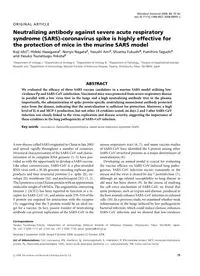
2009 Neutralizing antibody against severe acute respiratory syndrome (SARS)-coronavirus spike is highly effective for th PDF
Preview 2009 Neutralizing antibody against severe acute respiratory syndrome (SARS)-coronavirus spike is highly effective for th
Microbiol Immunol 2009; 53: 75–82 doi:10.1111/j.1348-0421.2008.00097.x ORIGINAL ARTICLE Neutralizing antibody against severe acute respiratory syndrome (SARS)-coronavirus spike is highly effective for the protection of mice in the murine SARS model Koji Ishii1, Hideki Hasegawa2, Noriyo Nagata2, Yasushi Ami3, Shuetsu Fukushi4, Fumihiro Taguchi5 and Yasuko Tsunetsugu-Yokota6 4Department of Virology I, 1Department of Virology II, 5Department of Virology III, 2Department of Pathology, 3Division of Experimental Animals Research and 6Department of Immunology, National Institute of Infectious Diseases, Toyama, Shinjuku-ku, Tokyo 162-8640, Japan ABSTRACT We evaluated the efficacy of three SARS vaccine candidates in a murine SARS model utilizing low- virulence Pp and SARS-CoV coinfection. Vaccinated mice were protected from severe respiratory disease in parallel with a low virus titer in the lungs and a high neutralizing antibody titer in the plasma. Importantly, the administration of spike protein-specific neutralizing monoclonal antibody protected mice from the disease, indicating that the neutralization is sufficient for protection. Moreover, a high level of IL-6 and MCP-1 production, but not other 18 cytokines tested, on days 2 and 3 after SARS-CoV infection was closely linked to the virus replication and disease severity, suggesting the importance of these cytokines in the lung pathogenicity of SARS-CoV infection. Key words coronavirus, Pasteurella pneumotropica, severe acute respiratory syndrome (SARS). A new disease called SARS originated in China in late 2002 and spread rapidly throughout a number of countries. Structural characterization of the SARS-CoV and charac- terization of its complete RNA genome (1–3) have pro- vided us with the opportunity to develop a SARS vaccine. Like other coronaviruses, SARS-CoV is a plus-stranded RNA virus with a 30-kb genome encoding replicase gene products and four structural proteins (i.e. spike [S], en- velope [E], membrane [M], and nucleocapsid [N]) (1, 2). TheSproteinisatypeIfusionproteinwithanapproximate molecular weight of 180 kDa. The angiotensin-converting enzyme 2 (ACE2) has been reported to function as a re- ceptor for SARS-CoV (4), and amino acids 270–510 of the S protein are required for interaction with the receptor (5), suggesting that the S protein would be an ideal tar- get for a vaccine. In fact, passive transfer of neutralizing antibody can prevent replication of the SARS-CoV in the Correspondence Yasuko Tsunetsugu-Yokota, Department of Immunology, National Institute of Infectious Diseases, Shinjuku-ku, Tokyo 162-8640, Japan. Tel: +81 3 5285 1111 ext. 2133; fax: +81 3 5285 1150; email:
